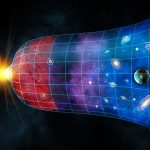Key Takeaways:
- Big Bounce simulations challenge the prevailing Big Bang theory of the universe’s origin.
- The standard inflation theory suggests a rapid expansion creating a multiverse, leading to conceptual concerns.
- A new cyclical universe theory aims to explain the cosmos without a Big Bang.
- Computer simulations by Paul Steinhardt and collaborators propose a slow contraction model.
- The bounce model offers a universe with no beginning, no end, and no multiverse.
The conventional narrative of the universe’s birth, often referred to as the Big Bang theory, posits that nearly 14 billion years ago, an immense surge of energy materialized seemingly out of nowhere.
In a rapid expansion, this burst of energy inflated the cosmos, straightening out its large-scale curvature and mixing matter together, resulting in a mostly featureless universe. This inflation theory aligns with all observations to date and garners support from most cosmologists. However, it predicts the existence of a multiverse, raising concerns that it predicts everything and, therefore, nothing.
Paul Steinhardt, a key figure in developing the inflation theory, has become one of its most vocal critics. Alongside others, he is exploring an alternative narrative for the universe’s origin, reviving the idea of a cyclical universe that periodically expands and contracts. Their goal is to recreate a flat and smooth universe without the complications of a cosmic explosion.

Steinhardt and his collaborators recently collaborated with gravity modeling specialists to analyze how a contracting universe would alter its structure. Their findings suggest that contraction can effectively counter inflation. Even if the universe starts with peculiar features, the contraction erases many primordial irregularities.
In this cyclical universe, the critical change occurs during contraction, driven by an energy field akin to dark energy. As the universe gently deflates over billions of years, the shrinking horizon plays a significant role in smoothing and flattening the cosmos. Eventually, a bounce occurs, restarting the cycle. This model ensures a universe without a singular beginning, end, or a multiverse.
Both inflation and bounce cosmologies face the challenge of demonstrating that their respective energy fields can create the desired universe under various conditions. Steinhardt and his team emphasize their philosophy that it should work without conditions. They stress-tested their slow-contraction model with a wide range of scenarios through computer simulations, consistently producing a universe as smooth as ours.
While interest in the slow-contraction model varies among cosmologists, most still consider inflation as the leading paradigm. The next step for the collaboration is to refine the bounce stage, which involves novel interactions to push everything apart again.
They hope to identify unique features of a bouncing universe that astronomers might observe. Although the cyclic cosmos without a Big Bang or crunch is not fully detailed, the researchers are optimistic about offering an alternative to the multiverse theory. Steinhardt no longer loses sleep over the roadblocks he once feared.


